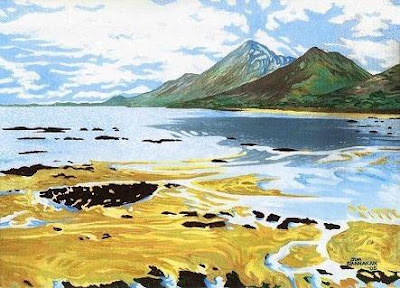 Moonstruck - detail
Moonstruck - detail Moonstruck - initial sketch
Moonstruck - initial sketch Moonstruck - final painting.
Moonstruck - final painting.As I noticed that some visitors to the site have an interest in faery art, I decided to insert a few clips of a work I did a while back. The yellow sketch shows the initial doodle on a post-it! I didn't really think about what I was going to end up with when I started. I had had a spare moment and I was just killing time at that time and letting my imagination flow. The drawing in pencil turned out okay and so I decided to keep it, and do a larger version, 12" x 16" on watercolour paper. When it came to scaling up I just drew it freehand and tried to keep it as close to the original idea while improving on the form where necessary. When I was happy with the pencil scaleup, I outlined it all with a very thin black felt tip type pen, being careful to not lean too heavy in the important areas, especially around the face. When it came to painting, I had a rough idea about what to do and went with it. The plan was to draw total attention to the centre and to do this I came up with the radiating pattern around the moon. Also the craters on the moon, I choose their location carefully so as not to impact on the outline of the faery. Choosing the colours for the faery was a happy accident as I had choosen a pale green, but decided it was lacking something. So I went over the body with a rose colour and it formed a nice brown. I tried to keep everything balanced so no part of the background colour took away from the faery by being too intense. I would like to think it's an okay effort.
 Faery school - initial sketch
Faery school - initial sketchHere again is another sketch, done around the same time, which I have drawn scaled up, and yet to complete. In the scaleup I have included a smaller faery on the rock and she is at faery school. The teacher is the central faery. If I get around to finishing it in the next while I shall include it as an addition to this post or link it back. These sketches often end up in the bin, and I've come to realise that it's not always going to be right first time and end up as a good idea. Some sketches are just that, sketchy! So it's important to just enjoy and see what happens.
That's it for now! I hope this interlude into fantasy was interesting to all.






